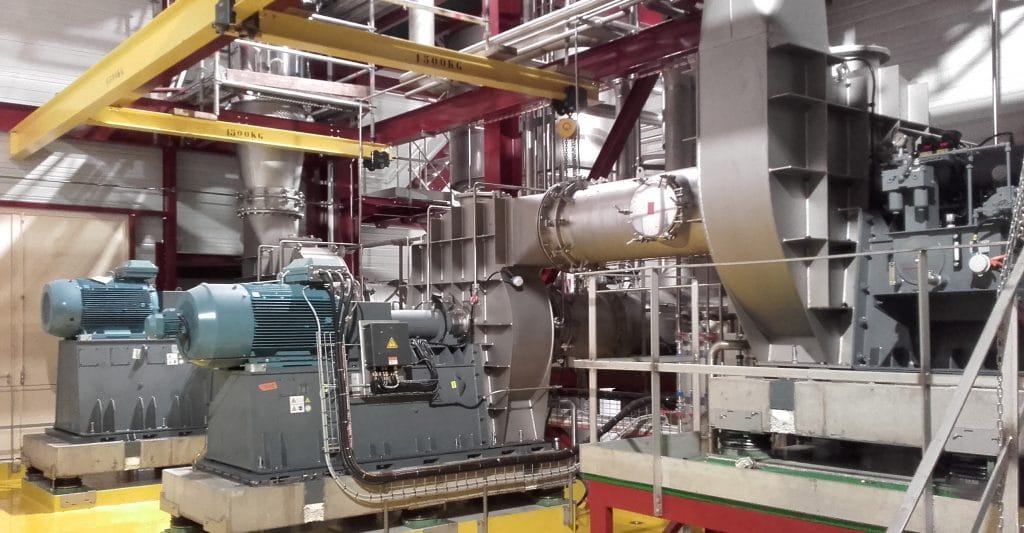Evaporation
TGE expertise will respond to your needs trough one of these technologies.
Falling film evaporator
Technology for which the product brought in the front of the evaporator flows inside a bundle of tubes under the effect of gravity. The tube bundle is heated usually by steam under vacuum, allowing the product to boil. Product and vapors are then separated at the bottom of the bundle of tubes by a separator. It can be integrated into the bundle or separated.
This type of evaporator allows:
• A small footprint (compared with forced circulation evaporators)
• A low residence time (in the absence of recirculation)
This evaporation technology is designed for products:
• With low viscosity
• Low fouling (without recirculation) to fouling (with recirculation)
This type of evaporator is the most used in the food industry, and more generally in the dairy industry. It is designed in particular for the concentration of milk, whey and their derivatives.
Forced circulation evaporator
Technology for which the energy input to the product and its boiling are done at two different times:
• The product is pumped from a separator to be sent in a tubular exchanger in which it is heated to a temperature greater than the boiling temperature of the separator;
• The product coming out of the tubular exchanger is returned in the separator placed under vacuum in order to be concentrated by flash evaporation there.
Unlike the falling film technology, the tubes are filled with product. The product is constantly in circulation. In comparison with the falling film evaporator, the footprint is more significant and the operating cost is higher because of the pumping of the product in recirculation.
This type of evaporator allows processing products:
• That have high viscosity;
• Very messy
• Crystallized
This evaporation technology is designed for products with high viscosity that are not very thermosensitive, as a result of significant residence time.
These 2 technologies can be offered specifics configurations :
Multiple effects evaporator
This type of configuration allows decreasing the needs for live steam compared to a simple effect evaporator .
The boiler steam is used to heat the first effect. The steam from evaporation produced from this effect allows heating the following effect. The steam from the following effect can be reused in the same way, or sent to a condenser.
The number of effects is variable. It depends on the characteristics of the product (thermosensitivity, crystallization…), on the cold source available to the condenser, the desired investment level and the steam consumption. It is usually between 3 and 6. Each additional effect reduces the consumption of energy, increases the investment, increases the residence time of the product in the installation.
The order of magnitude of steam consumption per ton of evaporated water is:
• Simple effect 1 000 kg/h
• Double effect 500 kg/h
• Triple effect 330 kg/h
• 6 effects 170 kg/h
The multiple effect evaporators also allow reducing the need for cooling water by reducing the amount of steam sent to the condenser.
Thermocompression evaporator
The thermocompressors are installed on multiple effect evaporators. They allow the reuse of steam to heat the first effect, or even intermediate effects. They therefore allow reducing the steam consumption and needs for cooling utilities with a low investment.
In order to perform well, the thermocompressor requires the use of high pressure steam produced from the boilers (between 4 and 15 bar).
Flash cooler (Flash evaporation pressure-drop)
Used after an evaporator, a flash-cooler allows instantly cooling the emerging product through pressure-drop towards a lower steam pressure. The use of this technology is particularly interesting ahead of crystallizers in order to initiate nucleation and to better control the kinetics of crystallization.
TGE makes flash cooling units, single or double stage, with or without energy recovery
Mechanical Vapor Recompression Evaporator (MVR)
The mechanical recompression of steam allows reducing the needs for steam to a minimum. Unlike thermocompression, which compresses only part of the steam, mechanical recompression can compress all steams through a mechanical compressor. The primary energy used becomes electrical energy. No energy is lost in this type of evaporator, making its energy efficiency excellent.
In addition, mechanical steam compression allows decreasing CO2 emissions compared to a multiple effect installation.
Steam consumption reduction makes mechanical steam recompression the key technology for your decarbonization strategy


